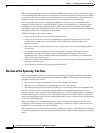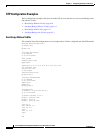
8-6
Cisco IOS Software Configuration Guide for Cisco Aironet Access Points
OL-29225-01
Chapter 8 Configuring Spanning Tree Protocol
Understanding Spanning Tree Protocol
Spanning-Tree Interface States
Propagation delays can occur when protocol information passes through a wireless LAN. As a result,
topology changes can take place at different times and at different places in the network. When an
interface transitions directly from nonparticipation in the spanning-tree topology to the forwarding state,
it can create temporary data loops. Interfaces must wait for new topology information to propagate
through the LAN before starting to forward frames. They must allow the frame lifetime to expire for
forwarded frames that have used the old topology.
Each interface on a access point/bridge using spanning tree exists in one of these states:
• Blocking—The interface does not participate in frame forwarding.
• Listening—The first transitional state after the blocking state when the spanning tree determines
that the interface should participate in frame forwarding.
• Learning—The interface prepares to participate in frame forwarding.
• Forwarding—The interface forwards frames.
• Disabled—The interface is not participating in spanning tree because of a shutdown port, no link on
the port, or no spanning-tree instance running on the port.
An interface moves through these states:
• From initialization to blocking
• From blocking to listening or to disabled
• From listening to learning or to disabled
• From learning to forwarding or to disabled
• From forwarding to disabled
Figure 8-2 illustrates how an interface moves through the states.
Figure 8-2 Spanning-Tree Interface States
When you enable STP on the access point/bridge, the Ethernet and radio interfaces go through the
blocking state and the transitory states of listening and learning. Spanning tree stabilizes each interface
at the forwarding or blocking state.
Power-on
initialization
Blocking
state
43569
Listening
state
Disabled
state
Learning
state
Forwarding
state


















